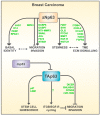p63 at the Crossroads between Stemness and Metastasis in Breast Cancer
- PMID: 31159154
- PMCID: PMC6600246
- DOI: 10.3390/ijms20112683
p63 at the Crossroads between Stemness and Metastasis in Breast Cancer
Abstract
After lung cancer, breast cancer (BC) is the most frequent cause of cancer death among women, worldwide. Although advances in screening approaches and targeted therapeutic agents have decreased BC incidence and mortality, over the past five years, triple-negative breast cancer (TNBC) remains the breast cancer subtype that displays the worst prognosis, mainly due to the lack of clinically actionable targets. Genetic and molecular profiling has unveiled the high intrinsic heterogeneity of TNBC, with the basal-like molecular subtypes representing the most diffuse TNBC subtypes, characterized by the expression of basal epithelial markers, such as the transcription factor p63. In this review, we will provide a broad picture on the physiological role of p63, in maintaining the basal epithelial identity, as well as its involvement in breast cancer progression, emphasizing its relevance in tumor cell invasion and stemness.
Keywords: TNBC; cancer stem cell; epithelial tumors; metastasis; p53 family.
Conflict of interest statement
The authors have no conflicts of interest to declare.
Figures




References
Publication types
MeSH terms
Substances
Grants and funding
LinkOut - more resources
Full Text Sources
Other Literature Sources
Medical
Research Materials
Miscellaneous

